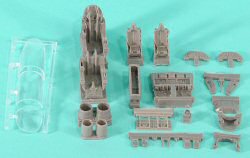
Classic Airframes 1/48 F-5B Freedom Fighter Kit First Look
By Michael Benolkin
| Date of Review | March 2007 | Manufacturer | Classic Airframes |
|---|---|---|---|
| Subject | F-5B Freedom Fighter | Scale | 1/48 |
| Kit Number | 4133 | Primary Media | Styrene, Resin |
| Pros | Detailed resin cockpit | Cons | Challenging to assemble |
| Skill Level | Intermediate | MSRP (USD) | Out of Production |
First Look
 |
 |
 |
 |
 |
Northrop developed the F-5 as a small, twin-engine, light-weight, multi-role fighter for the export market with hopes of interesting the US military as well. First flown in July 1959, the supersonic fighter entered service in Canada, Spain, Norway and the Netherlands. Other countries would adopt the agile and easy to maintain aircraft as development continued. The USAF would finally operate the aircraft in limited quantities in Vietnam.
While the F-5A/B lacked a decent radar, the aircraft was very agile and could hold its own in a dogfight. The F-5's small size made it difficult to acquire visually and would serve as one of NATO's principal point defense fighters for several decades. The Canadian Armed Forces also operated the CF-5 for almost 40 years, a testament to the aircraft's economy, flexibility, and utility.
The F-5B, like its pure trainer cousin, the T-38 Talon, was used as a trainer to orient pilots with the F-5A and demonstrate/practice aerial combat maneuvering and weapons employment procedures under direct supervision. Unlike the T-38, the F-5B was designed to employ the full range of air-to-air and air-to-ground weapons employed by the F-5A though it did not have the 20mm gun in the nose.
Classic Airframes released the Freedom Fighters last year and I was quite pleased the kit back then (see the F-5A review here). The kits feature some exquisite resin parts and capture these early F-5s quite nicely.
Molded in medium gray styrene, the kit is presented on three parts trees, plus the clear parts. The ejection seats, cockpit tubs, nosewheel and main wheelwells, speed brakes, and engine nozzles are all beautifully molded resin parts.
The parts breakdown is a little unusual and will be a little work for the modeler to get everything together. The vertical stab on the left side is a partial height molding designed to dovetail into the full-height half on the right side. A little dry-fitting, trimming, and filler will be required to make that seam go away.
The wings are separately molded but should not pose a problem as they attach with zero dihedral to the base of the fuselage, so you should have good alignment sitting wings and fuselage on a flat surface - ditto with the horizontal stabs.
The main wheel wells will be the other challenge. the outboard wells are molded as lower inserts into the undersurface of the wings. The actual fuselage wheel wells and speedbrake wells are molded as a single resin part that will insert into the underside of the fuselage. A styrene 'belly pan' will go next to enclose the rear portion of the fuselage underside. A little patience and lots of dry-fitting and trimming should minimize the need for any filler.
The resin cockpits are very nicely done! Ditto on the afterburner cans and speed board wells. You'll need the right tools for working with resin parts, but if you have built a Classic Airframes kit before, this will be a straightforward build.
Take some extra time with assembly as the fuselage halves and intakes may require some putty and shaping to get the model looking right.
Markings are provided for three aircraft:
- F-5B, 64-13380, 6 TFS, Philippine AF, Clark AB, PI, 1966
- F-5B, 4805, FAB (Brazilian AF), 1980
- F-5B, 63-8438, USAF, 1966
A nice set of maintenance stencils are also included.
This is the third release of the F-5B from Classic Airframes and I was a bit surprised that it was not as popular as the F-5A releases. Nevertheless, this kit (and its two siblings) are the best kits of the F-5B produced in 1/48 scale.
This kit is recommended!
My sincere thanks to Classic Airframes for this review sample!







